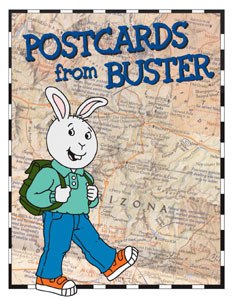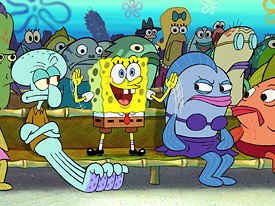The liberal left. The religious right. Dr. Toon gets in between the two sides of the culture war that has invaded toonland.

Postcards from Buster is the latest victim of the red and blue state cultural wars. © CINAR Corp.
Were it not for the omnipresent Culture Wars, American animation might become a very dull place indeed. We would have to be content with the latest CGI blockbuster, the unveiling of new fall schedules, and the hope that some independent artist stirs up the mainstream with something original or some snarky derivation of existing formulae. Instead, with 2005 barely two months old, we are treated to the infuriating sight of beloved animated characters being tugged back and forth by the Liberal Left and Religious Right. In a nation that has bitterly transmuted from Red, White, and Blue to Red or Blue, ideologues of the both sides are creating cultural tsunamis that engulf the populace with blather and outright venom.
Riding the latest tide is a famous yellow sponge and a perky white rabbit with a yen for the road. They hardly belong there. SpongeBob SquarePants and Buster are animated cartoons intended to entertain (in Busters case, to educate while doing so) but they have been turned instead into symbols of a nation at war with itself. Although there have been countless articles to date on the controversy described below, one thing has escaped the notice of dozens of pundits: What is being ignored is that history is actually repeating itself, retold with amplified media and spin in a time of political polarization.
For those hermits who have not been following the story, an organization known as the We Are Family Foundation recently produced a video featuring some 100 well known stars featured in movie and childrens TV shows. The only thing being sold, however, is tolerance for the differences between people, or such is the hope of producer Nile Rogers. Said characters will rock to a remake of We Are Family. The video, at the time of this writing, was set to air on March 11, 2005, with simultaneous broadcasts on the Disney Channel, Nickelodeon and PBS.
The Religious Right has plenty to say about We Are Family and Ed Vitagliano of the American Family Association fired the first salvo. His visit to the WAFF website revealed a Tolerance Pledge (not used in the video) that pledges respect for all races, creeds and orientations, including gays. Vitagliano further discovered material allegedly encouraging full acceptance of gay lifestyles. The Chair of AFA, Rev. Donald Wildmon, believes the video is a ploy to indoctrinate children into accepting that lifestyle as normal.
Although SpongeBob SquarePants is seen only briefly amongst the horde of kiddie stars, the AFA cannily chose the best possible target. Creator Steve Hillenburg has long asserted that neither he nor SpongeBob are gay, but SpongeBob has long been a favorite of the gay community. SpongeBob also has high visibility and tremendous marketing power. Rev. Wildmon, as some animation fans may recall, was instrumental in casting out Mighty Mouse: The New Adventures from the Saturday morning airwaves. Wildmon decried an episode where Mighty Mouse sniffs a flower; the Reverend saw this as an invitation for young viewers to snort cocaine.
Shortly after Nile Rodgers professed to be stunned by the AFAs accusations, Buster, the multicultural bunny, hopped into hot water. Buster is the brainchild of Bostons WGBH, an affiliate of PBS [animated by Cinar, which is now Cookie Jar]. The character barnstorms the country visiting different families in order to, help children understand and respect differences and learn to live in a multicultural society. The program, Postcards from Buster was doing well enough until the titular bunny sent a postcard from a lesbian couple and their three children living in Vermont.
Not only did the neo-con group Focus on the Family come after Buster, president Bushs Education Secretary followed suit. Margaret Spelling personally wrote PBS expressing concerns that, Many parents would not want their young children exposed to the lifestyles portrayed in the episode. What follows is an admittedly simplified version of how SpongeBob and Buster are now repeating history.
Whenever America is menaced by a foreign ideology, the definition of what is subversive to Americas children becomes an ideological battleground for the Left and Right. These battles often take place in the media, where our favorite animated characters live. It was not long after World War II that America was embroiled in another conflict, one unlike any fought before. Soviet communism was perceived as an aggressive threat to the world order. The United States was the purported leader of the free world, making it both a bastion and a prime target. As early as 1947, journalist Walter Lippman coined the phrase Cold War to describe the nature of the new conflict. One of the countrys responses to the challenge posed by Communism was to go to war internally.
Since the Russians could not successfully invade America, their chief weapon was widely believed to be subversion from within. It was mainly the political Right that espoused this idea and carried out the battle on two fronts during the 1950s. The best known was the purge and the witch-hunt, made famous by the ranting of Senator Joe McCarthy and legally carried out under the auspices of The House Committee on Un-American Activities (HUAC).

SpongeBob has long been a favorite of the gay community and has high visibility and tremendous marketing power. © 2004 Paramount Pictures and Viacom International Inc. All rights reserved.
Even closer to home was the ideological struggle against Red propaganda known as the Red Scare. With a Commie under every rock (and perhaps every government post), it was important to keep the ideals of America safe and whole. Freedom of expression and even of the press was more restricted than at any time in American history. Not surprisingly, conservative religious figures came to the forefront to combat the menace of Godless Communism; this was the age of Bishop Fulton Sheen, and of Reverend Billy Grahams crusades.
There is an overwhelming amount of evidence that homosexuals, as the subversive Other, were persecuted under the Red Scare. Gays were purged from government as security risks and, in 1950, Republican National Committee Chair Guy Gabrielson warned the nation about sexual perverts infiltrating the government. Senator Kenneth Wherry (R-Neb) told newspapers that You cant hardly separate homosexuals from subversives people of low morality are a menace in the government. This subject is covered in detail in David K. Johnsons recent book The Lavender Scare: The Cold War persecution of Gays and Lesbians in the Federal Government. In Hollywood films, Communists often showed hints of homosexuality, according to film critic Nora Saye. One signal film, My Son John, portrayed the titular character as an effeminate, intellectual liberal who betrays his country.
Naturally, homosexuals were seen as a threat to Our Children and the American Way of Life. Already threatened by rock n roll in the form of Elvis, horrific comicbooks decried by Frederick Wertham, and the media craze over juvenile delinquents as popularized by Marlon Brando and James Dean, children were now the targets of Communist propaganda (and its homosexual subtexts) as well. It was simply unthinkable to accept gays, and best if most children were shielded from all knowledge of such abhorrent things. Thus, conservatives, the nascent Religious Right, and the government closed ranks around the America idyll and the children living in it.
Eventually the ideals of the Civil Rights movement began to grow in the imagination of Americas marginalized. From roughly 1964-70 as an unpopular war raged in the background and faith in the government eroded, Blacks, women and gays proclaimed their own liberation and forged new identities in the national consciousness. The early days of the Multicultural Left were a-borning, and the newly formed counterculture took up its cause.
The Conservative Right now encountered formidable dissent, and, under president Ronald Reagan, the battles being waged today took sharp form. Reagan represented belligerent anti-Communism. Along with him rose the modern Religious Right, climbing aboard the political wagon around issues such as abortion, creationism, and the perceived erosion of culture/family values. The likes of Jerry Falwell, Oral Roberts, Pat Robertson made common cause with the likes of Pat Buchanan; this time their power was not limited to the airwaves, but to the very halls of Congress.
Again, the children had to be protected. As Reagan shook his gnarled fist the Evil Empire choked up and died. Pieces of the Berlin Wall found resting places in gardens and the American Way rose triumphant. Rev. Wildmon shook his fist and took down Mighty Mouse, secure in the fact that the times and politics were with him. Childrens programming had little to do with multiculturalism; under Reagans deregulatory policies, childrens TV was little more than extended toy commercials, most of it consisting of robots and warriors for boys and cutesy cuddle pals for girls. Gender roles were carefully preserved (as was the consumerist way of life) in one fell swoop.
But then, as noted, the Soviet Union was no more. Without an evil, subversive enemy in sight, conservatives and liberals turned on each other. The powerful neo-con movement led by Newt Gingrich squaring off against the Clinton White House was but a harbinger of the bitter political battles to come.
For a while, the multicultural factions did hold sway, and diversity was the keyword for much of the 1990s. So it went for childrens educational curriculums and television programming. Heather had two mommies, and political correctness and inclusion was largely the order of the day, especially in schools and universities. The pendulum swung back in 2000 with the election of George W, and the Right had its man in office. Battles over school prayer, stem cell research, public display of the Ten Commandments, and equal or ascendant time for Creationism raged more savagely than ever. Then came 9/11.
The threat now came from Islamic extremism, and there was no denying its ferocity. Terrorists were our new Communists, following a foreign faith and ready to strike at our heartland at a moments notice. Fears of dirty bombs, terrorist cells, anthrax attacks, and weapons of mass destruction ran rampant. Some of the immediate solutions put into action by the government, such as the Patriot Act and the Office of Homeland Security, were uncannily reminiscent of those used in the 1950s. Criticism of the President and his administration were seen as unpatriotic. When allies in Europe refused to support Americas assault against Iraq, the mentality of us against the world seemed like a reality.
As noted, when America is perceived to be under threat by a foreign ideology the conservative Right assumes a great deal of political power. Since the 1980s, their evangelical wing has had an increasingly insistent voice, and that voice is overwhelmingly conservative, exclusionary, and Christian. If the nation is to hold together under an indefinite threat following 9/11, it is reasoned, then the subversive Other must not warp Americas values and undermine the population, especially its youth.
Although the Religious Right has not openly associated gays with Islamic fundamentalism, they are using the opportunity terrorism provides to insist on maintaining strong values that will keep Americas children free from subversive ideals and lifestyles. The forces of antiterrorism and the push towards acceptance and tolerance for gays and others are two of the currents that have collided during recent times. In the churches, the courts, and throughout society, the Right has fought to keep gay lifestyles from being recognized and accepted (especially by children) while the liberal Left has refused to yield any gains made during the last decade or so of political correctness.
And so, against the backdrop of a New World Order gone awry, SpongeBob and Buster are trapped in a replay of earlier times when another monolithic ideology loomed menacingly over the leader of the free world. The Religious Right boasts a presumed mandate to remake the United States as a bastion of Christian values, whether the nation concurs or not. The Liberal Left would fill the airwaves and academies with like-minded folk, forcing the acceptance of diversity and the preaching of Tolerance or Else.

Martin Goodman.
It is interesting that the three feuding entities are named Focus on the Family, The American Family Association and the We Are Family Foundation. How adept they are at invoking that sacrosanct word in their titles, staking out what is essentially a private, personal arrangement run by vastly divergent rules as their own territory. The real battle is not over family; it is rather to determine who imposes their values upon a country.
For our purposes, the central debate is whether children are dangerously impressionable and whether cartoon characters can indoctrinate them with certain values at an early age that will turn them into acolytes of a particular viewpoint for life. It is not difficult to instill either hate or tolerance in a child, but having it stick is a relativistic crapshoot. One can expose a child to Buster and his lesbian hosts or restrict cartoon viewing to Tales from the Book of Virtues, but in the end, the overall socializing effects of an entire, diverse culture will interact with a maturing personality in unpredictable ways.
Children grow into teens that question the values of the generation that raised them, and the candidate of ones choice may not be the candidate of Dads choice. There are Yippies who became Yuppies; children of racists ensconced in interracial relationships; former acidheads now settled down in middle management. There was once an ardent Socialist named Elias Disney. He raised one of the most paranoid anti-Communists in Hollywood.
In the final analysis, no one entity is correct pushing their agenda or values as the absolute truth, and animated cartoons meant to be entertainment have no place in these divisive wars.
Martin Dr. Toon Goodman is a longtime student and fan of animation. He lives in Anderson, Indiana.







